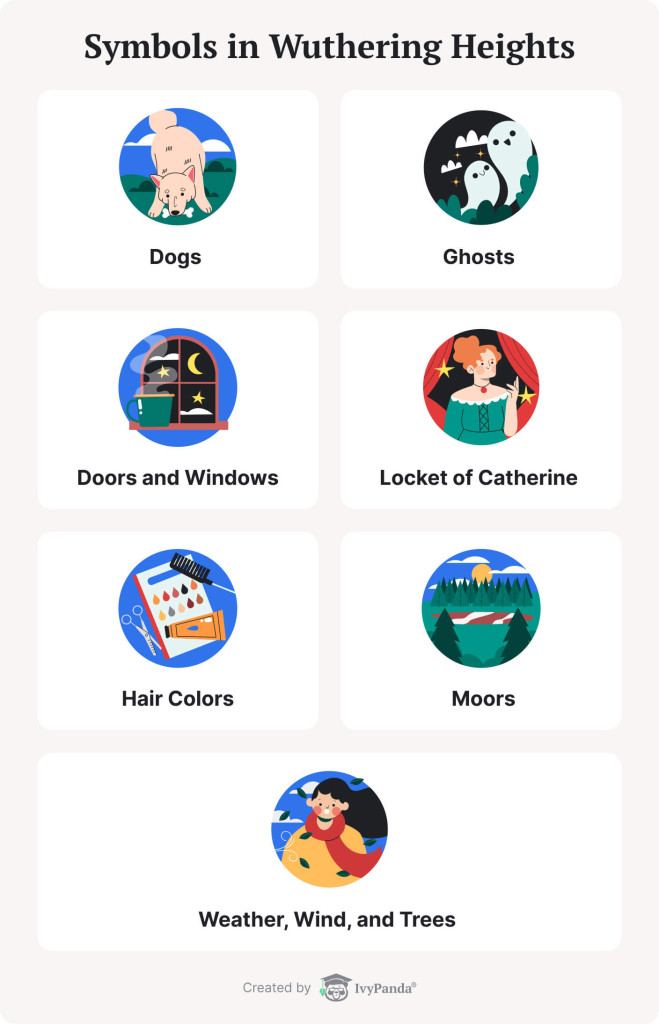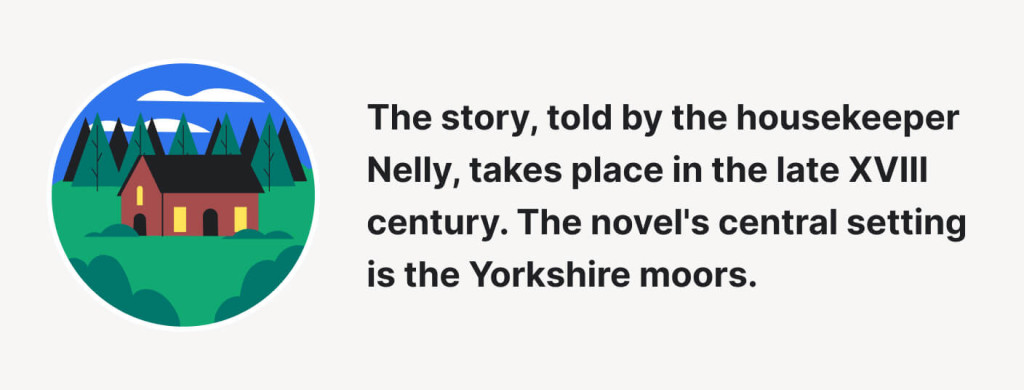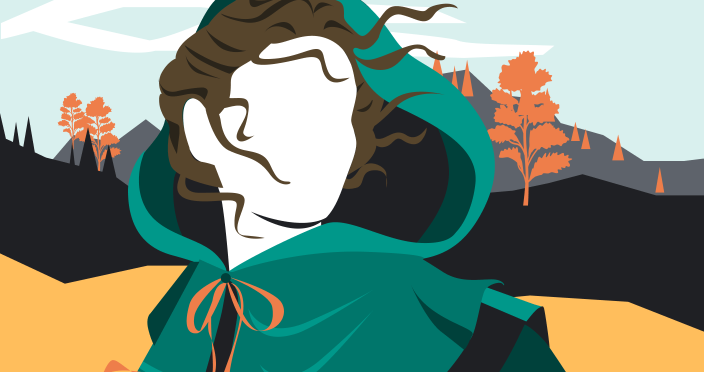Symbols in Wuthering Heights add depth to the story, creating a wild, untamed atmosphere that has made Emily Brontë’s novel a masterpiece of world literature. Natural symbolism reflects the characters’ inner conflicts and struggles—for example, in Wuthering Heights, dogs represent brutality, while moors are both the place of danger and freedom. In her research, Diana Ioncica (2022) points out how these motifs and other literary devices reveal the story’s deeper meaning in relation to Jungian archetypes and the unconscious.
This article will examine Wuthering Heights symbols in more detail. We will also explore:
- Emily Bronte’s use of figurative language. In Wuthering Heights, allusions and foreshadowing are featured prominently as ways to convey the novel’s themes.
- Wuthering Heights literary devices. Metaphors, similes, irony, and allegory will be explained in relation to the characters.
- The novel’s setting. One of the most prominent motifs in Wuthering Heights is the contrast between the untamed nature of the moors and the two estates where the characters live.
Let’s get down to our analysis!
👻 Symbols in Wuthering Heights
Wuthering Heights has different symbols. They create a unique atmosphere and emotional response people experience when reading. Check out their meanings:

Dogs
In Wuthering Heights, dogs symbolize violence and the brutality of human nature. They also serve as extensions of their masters’ personalities. For instance, when Lockwood attempts to enter Wuthering Heights, Heathcliff’s dogs attack him, reflecting their master’s lack of hospitality. Another example of these animals’ symbolism is Heathcliff’s treatment of Isabella’s dog, Fanny. He hangs up the dog, which foreshadows how this man will treat his new bride in the future.
Doors and Windows
Many characters can’t get what they want in the Wuthering Heights novel. So, doors and windows represent obstacles and the damaging effects of revenge. In the story, people are kept away by doors or try to escape through them. The most vibrant example of this symbolism comes when Heathcliff turns Catherine Linton into a prisoner and locks her inside Wuthering Heights. However, they also represent change, as seen when Heathcliff opens the window to let the ghost of Catherine Earnshaw return to her birthplace.
Weather, Wind, and Trees
These natural elements can be seen in the different scenes of Wuthering Heights, representing the wilderness and character emotions. The storms and rain depict passion, violence, and anger. The calmer weather represents peace and hope. Wind and trees symbolize how emotions shape the novel’s characters. They’re also an allegory of how the physical environment molds one’s character. For example, Heathcliff wants to see how Hareton will grow up in the same conditions as he did.
Ghosts
The ghosts represent the people who are haunting the residents of Thrushcross Grange and Wuthering Heights. They are also devices that show the past, memories, the themes of good versus evil, love, and obsession. Heathcliff, in particular, wants the ghost of Catherine Earnshaw to haunt him. In Bronte’s masterpiece, he goes as far as cursing her and wishing she would find no peace as long as he was alive. She doesn’t, and she only seems to leave the earth after the death of her love.
Moors
The moors represent several things throughout the Wuthering Heights novel. They are an infertile place that’s bare of any suitable agricultural land. In Bronte’s work, the moors show the distance between the characters and the physical locations of Wuthering Heights and Thrushcross Grange. They are also a wild country representing freedom away from unhappy home lives and class differences. It’s the only place where Catherine Earnshaw and Heathcliff can be happy together. But it also represents a danger, as the moors are hard to navigate without getting lost.
Locket of Catherine
Catherine Earnshaw’s locket is a physical representation of her heart. When she was alive, Catherine had a lock of Edgar Linton’s hair in the item, symbolizing her connection and love for the man. However, after her death, Heathcliff, like a true Byronic hero, finds the lock, throws it out, and replaces Edgar’s hair with his own. Nelly sees the replacement, intertwines Heathcliff’s lock with Edgar’s, and puts them both in the locket. This episode symbolizes that both men were crucial to Catherine and that their fates are linked.
Hair Colors
Emily Bronte heavily uses hair colors to represent different notions. Blond and bright hair colors represent aristocracy, privilege, gentleness, and education. They are also the symbolic sigil of Thrushcross Grange and the Linton family. Black and dark hair marks strength, passion, and lost privilege. It represents the Wuthering Heights and the Earnshaw family. Thanks to Cathy’s and Hareton’s love, these symbols are intertwined by the novel’s end.
💌 Figurative Language in Wuthering Heights
Emily Bronte used plenty of literary devices in her timeless novel. Check out vivid examples of figurative language in Wuthering Heights!
Foreshadowing
In many subtle scenes, Emily Bronte uses foreshadowing to foretell the fates of Heathcliff and Catherine Earnshaw. Some events predict what will happen later in the story, even the bittersweet ending where people get what they want the most.
One example is the night when Heathcliff runs away from Wuthering Heights. A summer thunderstorm had begun, which was out of season, and no one had expected it. It was a sign of the hostility to the world and the coming pain the young man would feel.
About midnight, while we still sat up, the storm came rattling over the Heights in full fury. There was a violent wind, as well as thunder, and either one or the other split a tree off at the corner of the building; a huge bough fell across the roof, and knocked down a portion of the east chimney-stack, sending a clatter of stones and soot into the kitchen fire.
Wuthering Heights, Ellen Dean, Chapter IX
Allusion
The book is full of allusions to gothic and romantic works. It has many references to Greek mythology, the Bible, and even fairy tales. This device shows that Emily Bronte was an avid reader. This quote from Wuthering Heights illustrates the use of allusion the best:
I was only going to say that heaven did not seem to be my home; and I broke my heart with weeping to come back to earth; and the angels were so angry that they flung me out into the middle of the heath on the top of Wuthering Heights; where I woke sobbing for joy. That will do to explain my secret, as well as the other. I’ve no more business to marry Edgar Linton than I have to be in heaven; and if the wicked man in there had not brought Heathcliff so low, I shouldn’t have thought of it.
Wuthering Heights, Catherine Earnshaw, Chapter IX
Conflict
Internal and external conflicts play a significant part in the novel. The main plot line revolves around Catherine and Heathcliff’s destructive love story. It also covers Heathcliff’s revenge against people who have wronged him, like Hindley Earnshaw. As for external conflict, Emily Bronte represents it through the issues of class differences in the Victorian era.
Irony
Despite the serious tone of the novel, it has some elements of irony, especially when it comes to Heathcliff’s character. When raising the son of Hindley Earnshaw, Heathcliff shows the same level of cruelty as he experienced in childhood. He wants to make Hareton suffer as much as he did, telling the boy with dark humor:
Now, my bonny lad, you are MINE! And we’ll see if one tree won’t grow as crooked as another, with the same wind to twist it!
Wuthering Heights, Heathcliff, Chapter XVII
Motifs
The writer uses the motif of pairs, organizing characters and places into sets of two elements. For instance, the novel describes two houses — Wuthering Heights and Thrushcross Grange, which represent opposing worldviews. Besides, Catherine’s character is divided into two conflicting sides: one wants to be with Heathcliff, and the other wishes to be with Edgar.
Another motif is repetition. In the novel, the names of the characters from different generations are repeated, and the events from the past happen again in the present. The cycle of revenge is a good representation of this motif. It is best described in this scene:
I’m trying to settle how I shall pay Hindley back. I don’t care how long I wait, if I can only do it at last. I hope he will not die before I do! […] I only wish I knew the best way! Let me alone, and I’ll plan it out: while I’m thinking of that I don’t feel pain.
Wuthering Heights, Heathcliff, Chapter VII
Personification
Emily Bronte uses personification in her descriptions of Wuthering Heights and Thrushcross Grange. Both places have the look and feel that represent their owners’ families.
One example of this literary device is the scene when Lockwood first met Heathcliff. The entire place was so unfriendly that even the gate was difficult to open. In this way, the author wanted to show that Heathcliff was not welcoming of Lockwood’s presence. Check out the example:
The ‘walk-in’ was uttered with closed teeth and expressed the sentiment, ‘Go to the Deuce:’ even the gate over which he leant manifested no sympathizing movement to the words; and I think that circumstance determined me to accept the invitation: I felt interested in a man who seemed more exaggeratedly reserved than myself.
Wuthering Heights, Mr. Lockwood, Chapter I
Similes
The author often uses similes to provide more vivid descriptions. This literary device makes readers better understand different characters and their traits. Here’s a quote that shows how Catherine sees her relationships with two men:
My love for Linton is like the foliage in the woods: time will change it, I’m well aware, as winter changes the trees. My love for Heathcliff resembles the eternal rocks beneath: a source of little visible delight, but necessary.
Wuthering Heights, Catherine Earnshaw, Chapter IX
Metaphor
Emily Bronte heavily relies on metaphors by comparing people to objects. The wild moors, where most of the story takes place, symbolize freedom, wilderness, nature, and the love between Heathcliff and Catherine. In the following example, you can see a metaphor about a sheep and a wild beast to represent the relationship of Heathcliff, the Earnshaws, and the Lintons.
I wanted something to happen which might have the effect of freeing both Wuthering Heights and the Grange of Mr. Heathcliff quietly; leaving us as we had been prior to his advent. His visits were a continual nightmare to me; and, I suspected, to my master also. His abode at the Heights was an oppression past explaining. I felt that God had forsaken the stray sheep there to its own wicked wanderings, and an evil beast prowled between it and the fold, waiting his time to spring and destroy.
Wuthering Heights, Ellen Dean, Chapter X
Imagery
Readers can come across many instances of imagery that evoke an emotional response. The setting creates a vivid backdrop that mirrors the volatile inner lives of the novel’s characters. Here’s what it looks like in the text when Catherine uses nature imagery to describe Heathcliff’s inner essence to Isabella:
Tell her what Heathcliff is: an unreclaimed creature without refinement, without cultivation, an arid wilderness of furze and whinstone. I’d as soon put that little canary into the park on a winter’s day as I recommend you bestow your heart on him! It is deplorable ignorance of his character, child, and nothing else that makes that dream enter your head. Pray, don’t imagine that he conceals depths of benevolence and affection beneath a stern exterior! He’s not a rough diamond—a pearl-containing oyster of a rustic: he’s a fierce, pitiless, wolfish man.
Wuthering Heights, Catherine Earnshaw, Chapter X
Allegory
Emily Bronte used allegory to represent the novel’s central idea — unrequited love traumatizes and destroys characters over generations. You can see it in how Heathcliff treats people around him, especially his wife, Isabella Linton, and Hareton, Hindley Earnshaw’s son.
However, the most perfect example of allegory is the image of two settings: Wuthering Heights and Thrushcross Grange. These places show two central male characters, Heathcliff and Edgar Linton. They’re like two horrible dark monsters. First, Edgar bullies Heathcliff because he’s a stranger. Then, once Heathcliff becomes influential, he begins to take revenge on the offender.
🏡 The Setting of Wuthering Heights
The locations of Wuthering Heights can be considered a literary device on their own, considering their significance throughout the story. The novel is set at the beginning of the 19th century, with most of its events taking place in the late 18th century. Its narrative is dark and rugged, and so are the main locations in the middle of the Yorkshire moors. The setting of Wuthering Heights can be interpreted as the nature of life that some can withstand and others can’t.

The two primary locations of this book are Wuthering Heights and Thrushcross Grange. The first place is dark and cold, located on a high hill. It feels almost like a castle, with the word “wuthering” being a local dialect used to describe the area’s turbulent weather and atmospheric conditions.
The second central location is its complete opposite: welcoming and bright, situated in a lush valley below. These places represent their inhabitants’ conditions and attitudes and, most importantly, the contrast between the wilderness and civilization.
We hope our analysis of the main symbols and figurative language can help our readers look at this novel differently. If you’re writing an essay on Emily Bronte’s Wuthering Heights work, please check out our great essay generator. We’re sure it will help you come up with gripping ideas for your work!
